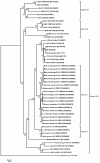Prevalence and phylogeny of coronaviruses in wild birds from the Bering Strait area (Beringia)
- PMID: 21060827
- PMCID: PMC2966397
- DOI: 10.1371/journal.pone.0013640
Prevalence and phylogeny of coronaviruses in wild birds from the Bering Strait area (Beringia)
Abstract
Coronaviruses (CoVs) can cause mild to severe disease in humans and animals, their host range and environmental spread seem to have been largely underestimated, and they are currently being investigated for their potential medical relevance. Infectious bronchitis virus (IBV) belongs to gamma-coronaviruses and causes a costly respiratory viral disease in chickens. The role of wild birds in the epidemiology of IBV is poorly understood. In the present study, we examined 1,002 cloacal and faecal samples collected from 26 wild bird species in the Beringia area for the presence of CoVs, and then we performed statistical and phylogenetic analyses. We detected diverse CoVs by RT-PCR in wild birds in the Beringia area. Sequence analysis showed that the detected viruses are gamma-coronaviruses related to IBV. These findings suggest that wild birds are able to carry gamma-coronaviruses asymptomatically. We concluded that CoVs are widespread among wild birds in Beringia, and their geographic spread and frequency is higher than previously realised. Thus, Avian CoV can be efficiently disseminated over large distances and could be a genetic reservoir for future emerging pathogenic CoVs. Considering the great animal health and economic impact of IBV as well as the recent emergence of novel coronaviruses such as SARS-coronavirus, it is important to investigate the role of wildlife reservoirs in CoV infection biology and epidemiology.
Conflict of interest statement
Figures


Similar articles
- Epidemiology of Deltacoronaviruses (δ-CoV) and Gammacoronaviruses (γ-CoV) in Wild Birds in the United States.Viruses. 2019 Sep 26;11(10):897. doi: 10.3390/v11100897.Viruses. 2019.PMID: 31561462Free PMC article.
- Coronaviruses from pheasants (Phasianus colchicus) are genetically closely related to coronaviruses of domestic fowl (infectious bronchitis virus) and turkeys.Avian Pathol. 2002 Feb;31(1):81-93. doi: 10.1080/03079450120106651.Avian Pathol. 2002.PMID: 12425795
- Divergent coronaviruses detected in wild birds in Brazil, including a central park in São Paulo.Braz J Microbiol. 2019 Apr;50(2):547-556. doi: 10.1007/s42770-019-00065-7. Epub 2019 Mar 15.Braz J Microbiol. 2019.PMID: 30877663Free PMC article.
- Coronaviruses in poultry and other birds.Avian Pathol. 2005 Dec;34(6):439-48. doi: 10.1080/03079450500367682.Avian Pathol. 2005.PMID: 16537157Review.
- Naturally Occurring Animal Coronaviruses as Models for Studying Highly Pathogenic Human Coronaviral Disease.Vet Pathol. 2021 May;58(3):438-452. doi: 10.1177/0300985820980842. Epub 2020 Dec 28.Vet Pathol. 2021.PMID: 33357102Review.
Cited by
- Reservoirs and vectors of emerging viruses.Curr Opin Virol. 2013 Apr;3(2):170-9. doi: 10.1016/j.coviro.2013.02.002. Epub 2013 Mar 13.Curr Opin Virol. 2013.PMID: 23491947Free PMC article.Review.
- Molecular Detection and Characterization of Coronaviruses in Migratory Ducks from Portugal Show the Circulation of Gammacoronavirus and Deltacoronavirus.Animals (Basel). 2022 Nov 25;12(23):3283. doi: 10.3390/ani12233283.Animals (Basel). 2022.PMID: 36496804Free PMC article.
- Coronaviruses in wild birds - A potential and suitable vector for global distribution.Vet Med Sci. 2021 Jan;7(1):264-272. doi: 10.1002/vms3.360. Epub 2020 Sep 24.Vet Med Sci. 2021.PMID: 32970935Free PMC article.Review.
- Genetic Diversity and Phylodynamics of Avian Coronaviruses in Egyptian Wild Birds.Viruses. 2019 Jan 14;11(1):57. doi: 10.3390/v11010057.Viruses. 2019.PMID: 30646528Free PMC article.
- Emergence of novel strains of avian infectious bronchitis virus in Sweden.Vet Microbiol. 2012 Mar 23;155(2-4):237-46. doi: 10.1016/j.vetmic.2011.09.022. Epub 2011 Sep 25.Vet Microbiol. 2012.PMID: 22005179Free PMC article.
References
- Cavanagh D. Nidovirales: a new order comprising Coronaviridae and Arteriviridae. Arch Virol. 1997;142:629–633. - PubMed
- Cavanagh D, Mawditt K, Sharma M, Drury SE, Ainsworth HL, et al. Detection of a coronavirus from turkey poults in Europe genetically related to infectious bronchitis virus of chickens. Avian Pathol. 2001;30:355–368. - PubMed
MeSH terms
Associated data
- Actions
- Actions
- Actions
- Actions
- Actions
- Actions
- Actions
- Actions
- Actions
- Actions
- Actions
- Actions
- Actions
- Actions
- Actions
- Actions
- Actions
- Actions
- Actions
- Actions
- Actions
- Actions
- Actions
LinkOut - more resources
Full Text Sources
Other Literature Sources
Miscellaneous

